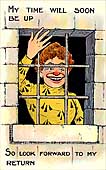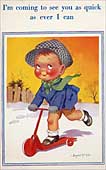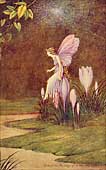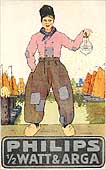PICTURE
POSTCARD MAGIC!
|
   
No hobby quite compares with collecting postcards in the way it caters for all interests. Whether you're a football fan, mad about the royal family, keen on local history, a railway buff or a student of ornithology, picture postcards offer you a marvellous stimulus for your hobby. And for those merely nostalgic and interested in the events and fashions of the past century, the postcard encapsulates it all. Postcards are fascinating and collectable in lots of different ways. Each example is a snapshot of the past: a moment, a slice of social history, frozen in time. Every postcard that has gone through the post tells you a little bit about its place in the bygone world. The picture, stamp, postmark, message and address are part of the life of two people - the sender and the recipient - in the past. Few collectors are lucky enough to find a postcard written by a famous person, but many writers referred to current events in their messages. Postcards provide a panorama of the events of the twentieth century: coronations, sporting confrontations, horrific accidents, local fetes, great exhibitions, world wars. They show the development of rail, road, sea and air transport. They feature actresses, bishops, politicians, cricketers and pier divers - anyone who might be newsworthy and heroic. National firms like Raphael Tuck of London and Valentine of Dundee published cards of countrywide interest, while in every town and city were local photographers who recorded all the interesting events of the day and published them as picture postcards. So a photograph of the annual sports in a village could be mailed anywhere in Britain - or, indeed, the world - to friends and relatives. The local railway station, cinema, colliery, church or school, and every street in the place, would appear on a card - anything that was part of a community was a likely subject for publishers to use. Some of the world's best-known serious and comic artists of the early 20th century had their work featured on postcards, including art nouveau exponents Alphonse Mucha and Raphael Kirchner. In Britain, Mabel Lucie Attwell's children, Alfred Quinton's landscapes, Louis Wain's cats, Tom Browne's ordinary people, and Donald McGill's henpecked husbands can all be found on cards. With such a wide choice of subjects to collect, there really is plenty to suit anyone's pocket. Even some cards a century old can cost just pence, though the best street scenes attract prices in excess of £20. Special subject cards - Titanics, suffragettes and football teams - can rate over £100, while more mundane themes - flowers, churches and country views - can be bought cheaply. Age doesn't always provide an indication of expense, either, for a card from the 1970's may sell for more than one from the Edwardian era. Whatever their subject or price, however, postcards can be fascinating, stimulating, and educational - but they never fail to interest.
|